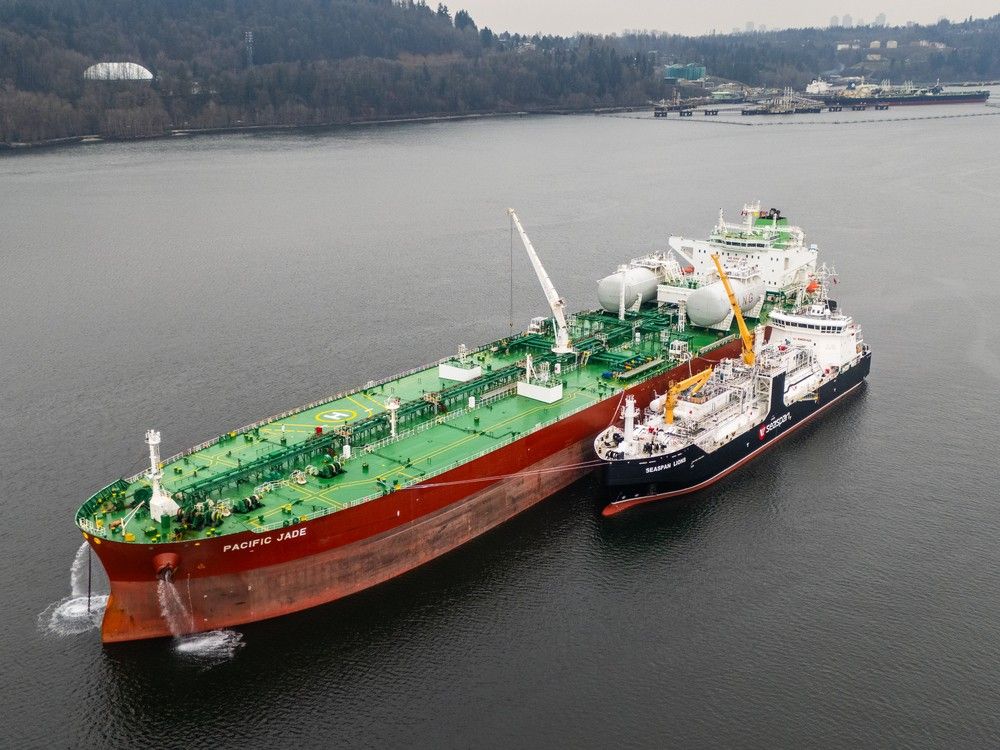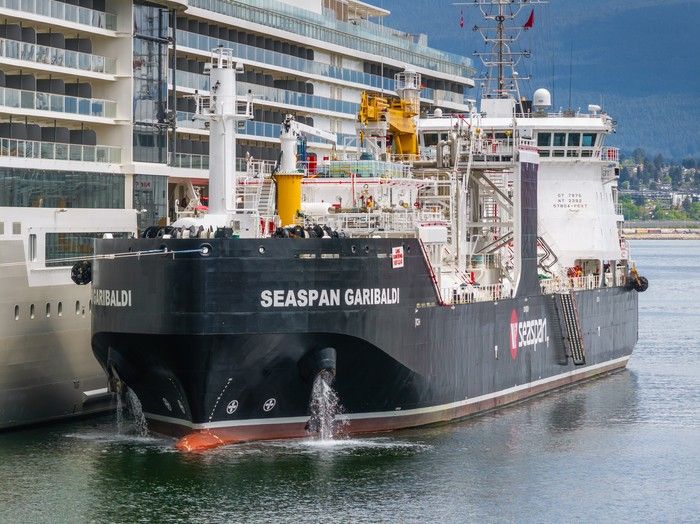
As most of the attention in B.C. has been on producing liquefied natural gas sector for export, the Port of Vancouver and shipping interests are quietly looking at using LNG to fuel ships.
The international shipping industry has been under pressure to reduce the emission impacts from burning notoriously carbon-intensive fuels, such as heavy oil, and LNG is seen as one of the most readily available alternatives to lessen that environmental burden.
Local maritime conglomerate Seaspan commissioned a fleet of three specialized LNG refuelling tanker ships to deliver some of B.C.’s LNG to the increasing number of ships being built or converted.
“There are emissions pressures coming from the international regulators of ships,” said Harly Penner, president of the Seaspan subsidiary that operates the tankers.
Those pressures, combined with Seaspan’s proximity to made-in-Canada LNG from FortisBC’s Tilbury plant in Delta, got the company to think, “OK, the market opportunity is here to create that business,” Penner said.
Seaspan refuelled its first ship, the oil tanker Pacific Jade, in the Port of Vancouver on Jan. 30, while it was at anchor off Trans Mountain’s Westridge Terminal in Burnaby.
Since then, two of Seaspan’s refuellers have topped up container ships, automobile carriers and even a cruise ship — the Silver Nova of the luxury Silver Seas line — on May 9.
The Vancouver Fraser Port Authority considers the arrival of Seaspan’s LNG refuelling capability as “a vital step” in its own objectives for reducing emissions from port operations, according to Shri Madiwal, vice-president of operations.
The introduction of high-capacity electric connections for cruise ships to plug into while in port, was an earlier step. Some 80 per cent of cruise ships that call on Vancouver now use that service. which means they do not have to run their electrical generators while docked here.
Making alternative fuels available is another step, Madiwal said in a news release, and “LNG is one of the most widely adopted alternative marine fuels and the first approved for bunkering at the Port of Vancouver.”
LNG use does come “with its own emission issues,” according to University of B.C. shipping expert Trevor Heaver.
“But if LNG is going to be a significant component of the change, then a coastal region — a port area — needs to have the capacity to service those ships,” said Heaver, a professor emeritus in operations and logistics at UBC’s Sauder School of Business.
Heaver said Seaspan’s service is a “technically needed, financially viable market component to service an element of the global shipping industry, which is already adopting LNG as one of the fuel alternatives to reduce carbon emissions.”
Domestically, Seaspan’s own private commercial ferry service, followed by B.C. Ferries, have already been using LNG as fuel, and FortisBC has had increasing sales in the marine sector, said Ian Finke, FortisBC’s director of LNG operations.
“This is why FortisBC is pursuing the development of a jetty at its Tilbury facility to support local marine fuelling,” Finke said in an email response to Postmedia questions.
Seaspan has also received approval to operate in Nanaimo and, through the U.S. Coast Guard, permission to refuel ships in the Port of Long Beach in California. A container ship at Long Beach was Seaspan’s very first customer last December shortly after it received its first LNG refuelling vessel from the shipyard, the Seaspan Garibaldi.

Built at the CIMC Sinopacific Offshore and Engineering shipyard in China, Seaspan’s three 112-metre long LNG tankers all have West Coast-mountain themed names, Seaspan Garibaldi, Seaspan Lions and Seaspan Baker.
During ship refuelling, referred to as bunkering in the industry, Penner said fuel is typically brought to vessels, most often by the barges often seen sidled up to cruise ships docked at Vancouver’s Canada Place cruise terminal.
“(Ship owners’) expectations are that those service providers — like groceries, fuel, lubrication oil — they come to them,” Penner said. “That’s just a norm, a market norm of how the market works.”
The LNG tankers, Penner said, give Seaspan the flexibility to take LNG to ships wherever they are.
“We’ll continue to desire to expand to ports in places like the Puget Sound, which includes Seattle, Tacoma, Port Angeles and the Oakland area, which includes San Francisco, Benicia, (Port of) Richmond,” Penner said.
He added that Seaspan has completed 40 refuelling jobs since taking delivery of its first LNG tanker late last year and expect to hit 80 by the end of this year.
“We’re in a building phase right now,” Penner said.
However, with industry analysts counting some 806 orders for LNG-powered ships since 2022, according to ship brokering company Fearnleys, Seaspan sees potential for growth.
“A large percentage of new cruise ships are being built using LNG as fuel,” Penner said.
“There is no segment that isn’t (building LNG-powered ships), except for the smaller domestic places that just don’t have the capabilities,” Penner added.